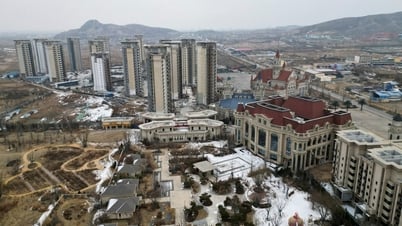In the first half of this year alone, the global technology industry cut 72,000 jobs, while the retail industry lost more than 64,000 jobs. April alone saw 7,235 layoffs, up 77% from the same period last year.
In Vietnam, more than 2,500 employees in banking, technology, and fast-moving consumer goods (FMCG) industries were laid off, and many textile, footwear, and electronics industrial parks... also reported large-scale cuts, as recorded in the second quarter 2025 report of a recruitment and employment unit.
These figures show that layoffs are becoming a global trend, no longer limited to short-term crises but gradually becoming part of the long-term strategies of many businesses.
Which industry group has cut staff the most?
Statistics from the financial reports of the second quarter of 2025 and the first 6 months of the year of listed enterprises show that layoffs are occurring on a large scale.
Specifically, in the retail sector, Mobile World Investment Corporation cut more than 1,000 employees in the first half of the year. The total number of employees reduced by this unit was 1,353, equivalent to 2% of its scale, bringing the total number of employees as of June 30 this year to 61,779 people.
Vietnam's technology industry is not out of the global trend, when for the first timeFPT Corporation cut 497 employees, accounting for 1% of the total number of employees. Currently, FPT is still the technology enterprise with the largest number of employees in Vietnam with 54,149 people. VNG Corporation also reduced 92 employees, equivalent to 3% of the workforce after 6 months.
In the financial sector, statistics show that thousands of bank employees were cut in the first half of the year. Of which, LPBank was the bank that cut its staff the most in the first half of this year (reducing up to 1,986 people). SSI Securities Company also reduced 151 people, equivalent to 10% of its total human resources and VNDIRECT reduced 88 people, equivalent to 8% of its total human resources after only 6 months.
Similarly, in other sectors, for example, in the fast-moving consumer goods (FMCG) industry, Vietnam Dairy Products Joint Stock Company (Vinamilk) has reduced 311 employees (3%), or in the seafood industry, Vietnam-Australia Seafood Company has cut 292 employees, accounting for 16% of the total workforce...

Experts predict the downsizing trend will continue for the next 2-3 years.
Ms. Dieu Hoang Tu Uyen - Director of Human Resources Research and Consulting of Anphabe - said that the current developments in the market are causing many key fields to undergo organizational transformation and streamlining, and human resources are an inevitable part of this process.
According to her, the financial industry is a representative of the value shift group, when the pressure to optimize performance and competition is driven by technology (automation and artificial intelligence) to move values from manual processes and physical factors to digital spaces and customer experiences.
For this group, downsizing is a strategic move due to restructuring and technology transformation, a proactive move to change the business model, optimize operations and anticipate the future.
Other industries that are joining this race include technology, retail, FMCG and logistics. According to Ms. Uyen, these are long-term structural changes that will certainly continue in the next 2-3 years. The story of streamlining human resources will not really be massive and happen all at once, but will depend on the stages and transformation goals of the business.
Some businesses even set targets to gradually reduce the number of employees in certain functions over time as corresponding performance gains in technological maturity increase.
On the other hand, there are also some industries and businesses where the trend of cutting staff is a result of a defensive reaction to the difficult economy and market cycles. For this group, the development will be directly affected by the government's macro policies and consumer attitudes (e.g. real estate or construction) or fluctuations in the health of the global economy (e.g. manufacturing, export groups), so it is difficult to predict in the long term.
Anphabe representative predicts that when the economy stabilizes and macro policies operate more smoothly, recruitment demand will return strongly, but it is unlikely to be clear in the short term.
Supply and demand are out of phase, what should businesses do?
Results from a study of nearly 3,000 participants (nearly 2,000 workers and nearly 1,000 businesses) in the May-June period by a unit on employment and recruitment showed that the number of laid-off workers is increasing, with more than 72.7% actively looking for work again. However, only 24.7% found suitable jobs in a short time, showing that the journey to reintegrate into the market is full of challenges.
On the other hand, businesses are still seriously lacking in staff. Up to 77.4% of businesses said recruitment was more difficult than the same period last year, especially for official and mid-level employees - positions that are considered the "backbone" of operations.
The most difficult positions for businesses to recruit according to Vieclam24h survey

The report also highlights the phenomenon of supply and demand, but not meeting. This apparent paradox reflects a growing disconnect between job seekers and employers, no longer a matter of numbers, but a gap in expectations, skills and mentality.
Workers need to maintain a flexible and adaptable mindset, invest in continuous skill development (especially sustainable and hard-to-replace skills), proactively build their personal brand, not let insecurity influence their decisions, thoroughly research the business and the market, adjust realistic financial expectations, and make the most of job search tools...
Source: https://dantri.com.vn/kinh-doanh/hang-nghin-nhan-su-mat-viec-lan-song-cat-giam-khi-nao-ket-thuc-20250808124608691.htm





![[Photo] Images of the State-level preliminary rehearsal of the military parade at Ba Dinh Square](https://vphoto.vietnam.vn/thumb/1200x675/vietnam/resource/IMAGE/2025/8/27/807e4479c81f408ca16b916ba381b667)


![[Photo] Parade blocks pass through Hang Khay-Trang Tien during the preliminary rehearsal](https://vphoto.vietnam.vn/thumb/1200x675/vietnam/resource/IMAGE/2025/8/27/456962fff72d40269327ac1d01426969)































































































Comment (0)